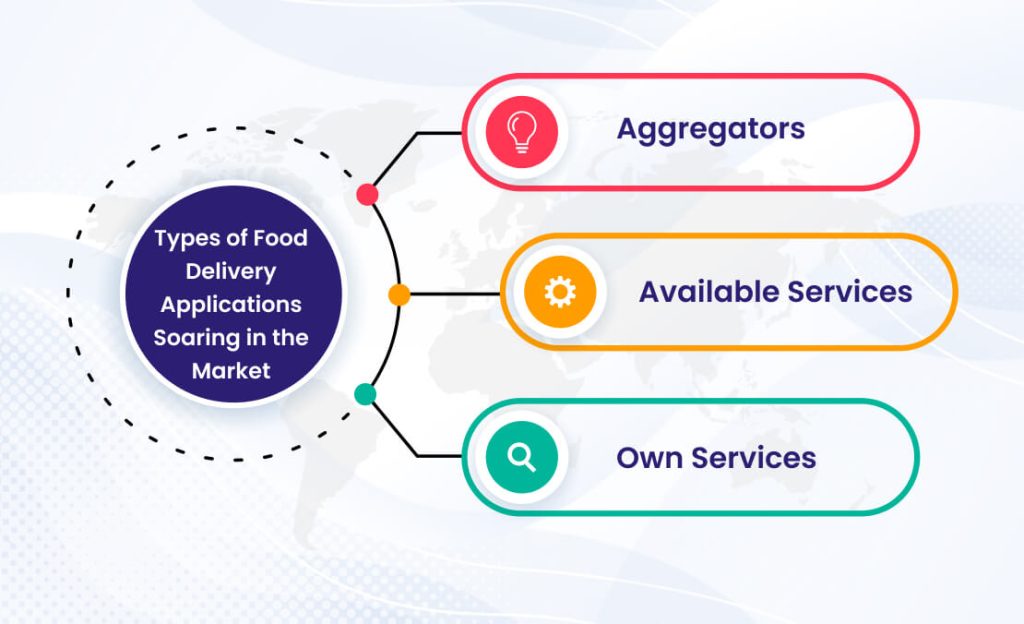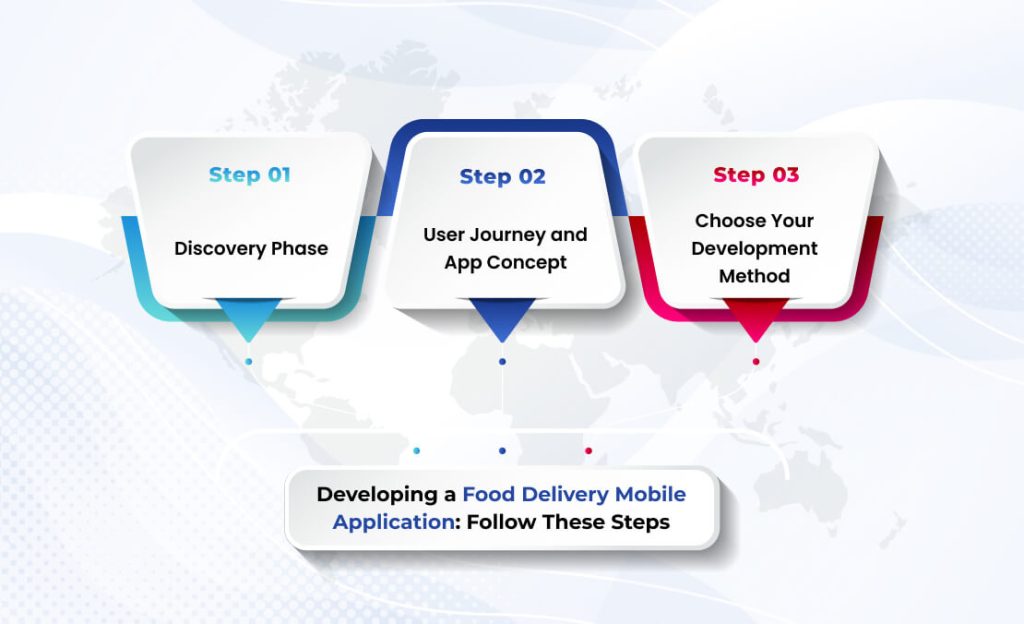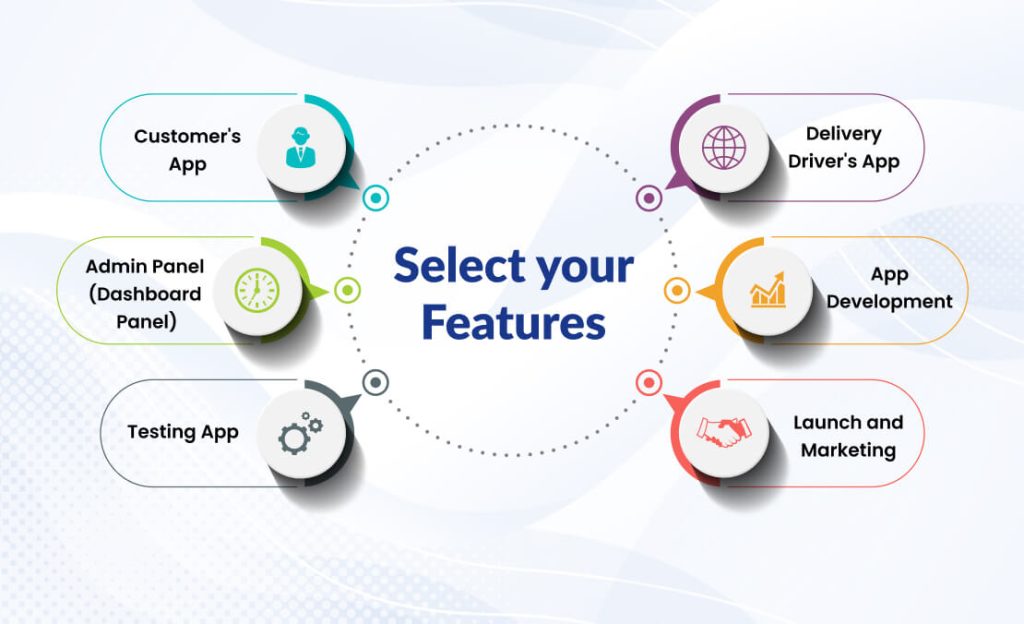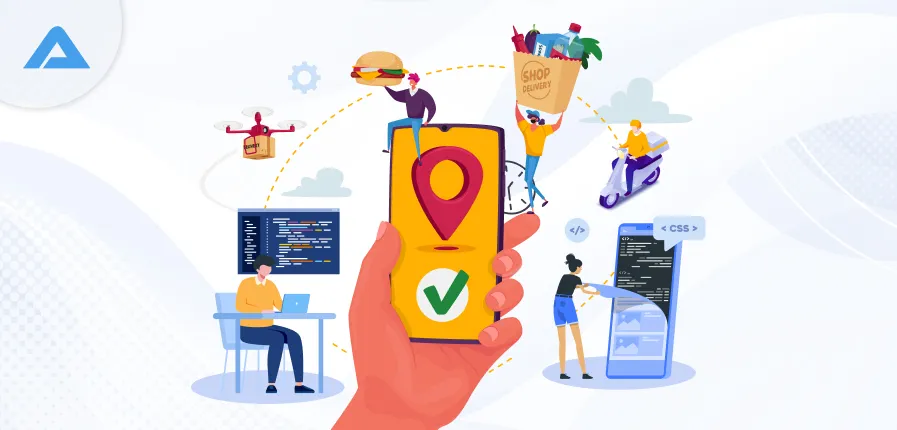Food delivery apps are one of the fastest-growing businesses around the globe.
Business of Apps reports that the number of US food delivery app users was approximately 111 million in 2020.
By 2025, this market is projected to reach US$4441,622 million with an anticipated compound annual growth rate of 9.89% annually (CAGR from 2021-2025).
Within three years alone, people purchasing food online has nearly quadrupled from 364.8 million individuals in 2017 to 625.9 million as of 2020.
Convenience is the primary driver. These apps are a convenient and quick way to satisfy food cravings in an age of busy schedules, rapid digitalization, and hectic lifestyles. Integrating AI with data analytics allows for highly personalized experiences that suggest curated food options that resonate perfectly with the user’s tastes.
As consumers are willing to pay a premium for convenience and personalization, startups and entrepreneurs can take advantage of food delivery app development and become key players in the sector. This is possible by investing in app development.
Types of Food Delivery Applications Soaring in the Market

The food delivery market is growing rapidly, becoming a vital part of our daily lives. Mobile food delivery applications can operate in three different modes, each with its own characteristics.
Aggregators
The site offers a variety of menus. The aggregator manager sends the order to the restaurant courier service. The aggregator generates revenue from partner conditions.
The business benefits include the reduction in the need to develop an app and the increased reach of your audience.
The loyalty is developed towards the aggregator and not the restaurant. Payments are substantial, which reduces the profitability of the dish, even though the overall profit increases. Even if the owner of the aggregator does not have a business, they can still make money by providing food delivery services. Just Eat (UK) and GrubHub are two examples.
Available Services
Recent developments have seen the emergence of new services which act as aggregators and delivery services for restaurants. Owners of these businesses are responsible for establishing their courier service and organizing logistics for food deliveries from companies. Examples include DoorDash, Postmates, etc.
Own Services
The best investment for large and medium-sized businesses is to develop a mobile food delivery app. Domino’s Pizza app is an example.
Working Process of Food Delivery Applications
To ensure the development of a successful food delivery application, it is essential first to understand the way similar apps operate.
Step 1
Customers will receive suggestions of nearby restaurants, along with any daily specials. The customer has complete control from selecting a restaurant until the final payment.
Step 2
Customers can check their selection after adding the item to the shopping basket before checkout.
Step 3
The restaurant will be notified when your order is complete, and they can start cooking. You will need to be able to coordinate the order between the customer, restaurant, and delivery person to create a food-delivery app.
Step 4
A delivery person will collect the order and deliver it to the customer’s address. All must run smoothly and efficiently.
Business Model for Food Delivery Mobile App
Most food delivery apps, such as DoorDash Postmasters and Zomato, follow a similar model. Both a mobile food delivery application and a restaurant locator work together.
This concept is a digital version of the traditional model for food delivery.
The app acts as a platform that offers access to a variety of restaurants and, at the same, maintains a logistic network for delivery personnel.
Order-Only
This type of software helps connect diners to nearby restaurants. The application allows users to place orders with their favourite restaurants.
Restaurants can benefit from these sites by increasing their customer base without paying for traditional advertising.
Order and Delivery
This concept can be a great help to startups in the food delivery industry that do not have the funds or the manpower.
This strategy has many positives from the restaurant’s perspective. This concept does not require additional staff or vehicles.
Developing a Food Delivery Mobile Application: Follow These Steps

By taking an organized approach when creating an on-demand food delivery app solution, you can increase the odds of winning the market. Below are several steps that you can follow to develop an on-demand food delivery app that stands out in an increasingly competitive space.
Discovery Phase
To begin a discovery phase, it is essential first to understand the business of the client and the landscape of the market. We schedule a meeting to discuss the client’s ideas and needs. We also perform a thorough market analysis to identify the competition, unmet market needs, and the perception of the target market.
After understanding the landscape, it is time to develop a food-delivery app that meets these needs. Wireframes and a product road map that describe how the app functions are created. The wireframes will be used to develop a prototype for the app.
Validating the concept with users is the next step after the prototype has been completed. User testing or focus groups can be used to validate the idea. After feedback has been gathered and incorporated, you can move on to developing the food delivery app.
User Journey and App Concept
After gaining a thorough understanding of your market, you can create a concept to guide the development of your food delivery application. The next step is to define the app’s main features and functionality and map the user journey. Consider the branding and visual identity of your app, and ensure that it is aligned with the preferences of your target audience.
The user journey should be seamless and user-friendly for customers to place orders quickly and effortlessly. Speak with a mobile app development company about your challenges to gain better insight into the mobile user journey. They will assist in identifying user interface design (UI) and user experience design (UX), making your app intuitive yet visually pleasing for end-users, keeping with the brand’s visual identity across screens for seamless use across screens, and ensuring the app maintains consistent branding & visual identity throughout.
Choose Your Development Method
You can create a mobile app for meal delivery in a variety of ways:
- Using a mobile app developer
- App Creator: Create your app
- Using internal resources
- App development companies can provide you with the services that you need.
The third alternative is impractical for most companies because they need an internal IT team. Outsourcing or hiring a programmer are two expensive options.
Select your Features

All food delivery apps share a few features in common, but you can customize yours according to your company’s model. Select your features carefully, as they will guide the entire development process. Select features that support your main app objective.
If you are developing a restaurant-delivery service, consider placing a menu to display food items above non-essential features such as social network integration and discussion boards.
We’ve compiled a list of features that any current food ordering system or delivery platform should include for drivers, customers, and restaurant owners. Check out the latest features.
#Customer’s App:
- Search filter: Let your app users explore restaurants, cafés, and bars by location and cuisine. You can curate your search filter by different restaurants and dishes. Ordering food is made easy.
- Order Placing: Make placing orders easier with just a few taps. They can navigate intuitively to the checkout procedure. Add their favorite dishes to the order using an ‘add-to-order’ feature. Then, guide them to the final ‘checkout’ and payment process.
- Real-Time Tracking: Customers can track their order via a Google Maps integration. Users can check the estimated time of arrival for a driver. This builds trust in the service.
- Payment gateway integration: Integrate your apps with payment gateways, such as Zomato or GrubHub, with payment gateways, like PayPal, Stripe, and Braintree. Users can make payments with credit/debit cards easily. Make sure you offer your customers multiple payment options.
- Real-Time Availability: Let your users check the availability tables in different restaurants by developing a food app. You should allow them to book in a few easy steps.
- Rating and Reviews: This feedback is necessary to understand the response of your food online app. Allow your users to review and rate your app so you can fix any problems in due time.

#Delivery Driver’s App:
- Login or Signup: Allow your drivers to log in through social media sites like Gmail and Facebook. Entering personal information will make the registration process easier for drivers.
- User profile: Let drivers create a profile with a photo and include their name, email, phone number, photo, etc. The drivers can update their profiles.
- New Order Alert: Drivers should receive push notifications when new orders are assigned. They should receive a notification even when the application for food delivery is closed.
- Manage Multiple Delivery: Drivers can manage multiple food delivery requests at the same time and can respond to any other request that is nearby.
- GPS integration: For the delivery boy to complete the delivery at the last minute and deliver it on time, he must choose the fastest and shortest routes to get to the user’s location. It also allows him to reach the correct destination per the user’s request.
#Admin Panel (Dashboard Panel):
- Monitoring Performance: The admin panel lets you easily monitor drivers’ performance, schedule/cancel orders, and other data.
- Manage orders: Manage all activities from pickups to dispatch and scheduled orders. You can streamline your orders this way and ensure that they are delivered to customers on time.
- Real-Time Updates: Receive real-time updates and notifications when the restaurant owner and driver update their restaurant information and change availability.
- Payment Management and Commission Management: Allow owners to set up payment and commission rates and manage them directly from the admin panel.
App Development
The next step after the design is finalized is to begin development through coding the app and integrate its features. It is essential to optimize the app’s performance so that it runs smoothly.
MVP products can be used to start developing food delivery apps. A company that specializes in MVP development can create your app with the minimum features and functionality so you can test it with real users. As per the feedback from users, you can update the app by integrating features and further optimizing it.
Testing App
While developing your app, regular testing with an established software testing company should help to detect and eliminate bugs or issues and to make sure various users can utilize your product across devices and operating systems. User testing also serves an invaluable function: giving feedback about its functionality and experience for your users.
Launch and Marketing
Marketing techniques designed to encourage downloads can increase visibility. Businesses may be encouraged to adopt your app by offering early incentives like 20% discounts off of first orders placed through it.
A systematic approach is required to create an on-demand application. In this increasingly competitive market, you can develop and release an app effectively by verifying your concept, choosing the best development method, figuring out what your business model is, carefully selecting features, and implementing a solid marketing strategy.
Monetizing Methods for On-Demand Delivery App
The profitability and sustainability of food delivery application development depend on monetization. Three viable business models for instant delivery apps:
Subscription Models
Subscription-based revenue models are a reliable source of income. SaaS-based systems can be used by food and grocery delivery services. These simple methods do not require the creation of an app. DeOnDe subscription services allow businesses to offer services quickly without developing an app.
Commission-Based Models
Mobile apps that offer on-demand delivery often charge businesses to connect them with hungry customers. Uber Eats prohibits restaurants from increasing rates to cover the 30% commission fee on each order. Commission fees must be reasonable for all parties, even if they are burdensome for small businesses. Consider other revenue streams.
Advertising and Partnerships
Delivery apps sometimes work with restaurants to promote their listings or homepages instead of pop-up advertisements. Both the app and restaurants benefit from this strategy.
Your business goals and type will determine the best strategy to generate income for your instant-delivery application. A balanced and well-planned approach will ensure a steady income as well as a high level of customer satisfaction.
Tech Stack for Food Delivery Apps
- Platform: Android, iOS, Web
- Real-Time Analytics: Flink, Storm
- Database: Postgres, HBase, MongoDB, Cassandra
- Payments: eWallets, Stripe PayPal, Braintree Net Banking
- Voice, SMS, & Phone Verification: Twilio, Nexmo
- Push Notifications: Twilio, Push.io
- Cloud Environment: Azure, Google, AWS
- Navigation: Map of Google
So How Much Does It Cost? Comparing the Factors
Four factors usually determine the cost of developing a food delivery mobile application:
- The number of features in an app determines its complexity. More features mean higher costs.
- The cost of the app depends on the number of platforms it is built on. This could be iOS, Android, or both.
- The cost of mobile app development per hour in the USA, Europe, and India is much higher.
- 3rd party API integration, more API integration means more development effort.
- A basic food delivery application in the USA or UK, which is based on Android or iOS, will cost you approximately.
Technical documentation: $1,000 – $1,500/40 hours
UI/UX Design: $1500 to $3000 / 50-60 Hours
Front-end and back-end Development: $8,000 – $15,000 / 400 Hours
MVP Testing: $2,000 – $4,500/75-80 hours
Bug Fixing: $1,000 – $3,000/40 hours
The cost of a simple app on one platform, if you hire an experienced food delivery app development company to work on your project, can range from $2000-$25000.
If you add more features or more than one platform to the package, it could cost up to $35000-$45000.
But Must Consider These Factors Before Developing a Food Delivery Application
You need to take into consideration a few factors before you start the app development.
Stay Aware of the Latest Trends
Trends heavily influence the food delivery market, as users tend to gravitate towards “hot” apps that offer popular features. If you adopt these features, you’ll retain clients.
You should first determine what your customers want. What features are customers looking for in food delivery services? Think about integrating smartwatches, virtual assistants, and social media.
Research your Market
You must first determine the needs of your audience to create an app for food delivery that meets their expectations. Compile a basic demographic profile for your audience. Include factors like age, gender, and country.
App Features to Look for
Registration and login are two of the most essential features to include in an app for food delivery.
Users can quickly log in with social media accounts.
Search is another essential aspect to consider. Other important elements include ordering, payment alerts, and order monitoring.
Select Technologies for the Development
To implement different functionalities, you’ll need to use a range of technologies. If you want to list restaurants, for example, you will need the FourSquare or GrubHub APIs. You can accept and process payment using popular gateways like Square API, Braintree Stripe, and PayPal.
You’ll also need to include technology that can pinpoint the location of your users to deliver food. Google Maps and Core Location Framework, as well as Google Places API, are excellent options.
Other popular technologies that can be used for push notifications include Amazon SNS (Social Networking Service), Urban Airship, and Firebase Cloud Messaging.
The Key Takeaway
If you’re a business owner and want to create an app for on-demand food delivery, you need a thorough market analysis, industry expertise, and a realistic budget. In this guide, we have shared the features of on-demand food deliveries, business models, and revenue models, as well as technologies that may help you create a perfect app.
It’s crucial to know which market you plan to target for food delivery, what problems or challenges to overcome, and your goals before developing an app with many features.
There are two ways you can deal with the competition in the industry of meal delivery apps. You have a choice: let the competition deter you from entering the industry or go ahead with a new strategy.
Food delivery companies must constantly reinvent themselves to keep up with the fast-paced changes in the industry. The fierce competition that exists is also a factor. Your top priority as a business person should be to increase the utility of meal delivery.
FAQs
The process of creating a food-delivery app is a multi-step process. The first step is to conceptualize the app and identify the target audience. You must then determine the app’s functionalities, features, and design. Next, you must develop the app, test it thoroughly, and launch it on platforms relevant to your business. To ensure an efficient and smooth process, it is best to hire a team of app developers with experience or collaborate with them.
The complexity, features, and resources required to develop a food delivery application will determine how long it takes to create an app. The typical development process includes requirements gathering, UI/UX, development, testing, and deployment. It is best to discuss timelines with a seasoned app development company to obtain a more accurate estimation.
The cost to build an app similar to Uber Eats depends on its complexity, features, and the development resources needed. A similar app could cost up to several hundred thousand dollars. The cost of an app can be affected by factors such as the design, team rates, compatibility with platforms (iOS or Android), integrations with payment systems, and advanced features like real-time monitoring and user ratings.
When it comes to monetizing food apps, you have two options:
Your service charges for each order can be fixed or variable. Restaurants can also pay a fee to be listed on your app and receive recommendations.
A fee is charged to the customer for the use of the service. You may also benefit from high delivery volumes during certain hours of the day. You can add the surge fee during lunch and dinner rush hours. You can charge more for delivery if you want to make extra money.

Are you interested in developing an on-demand food delivery application?

Pooja Upadhyay
Director Of People Operations & Client Relations

